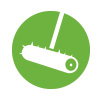
May 02, 2013 | Cody Stuart
How To: Spring Cleaning For Your Lawn
Whoever coined the phrase "spring has sprung" should have added an amendment discussing the helping hand it needs to get there. As anyone who's ventured out to their backyard on that first warm spring day knows, the onset of spring also signals the onset of spring cleaning. CREB®Now has some handy tips to help alleviate some of the aches and pains of making your backyard ready for the beginning of another spring season.
 Grab a Rake
Grab a RakeCome spring, fallen leaves, branches and other victims of the long winter months provide the normal yard decorations for most Calgary homes. An important first step in making your lawn more lush than loathsome is to clear it of all that rubbish. Making sure to don work gloves (nobody likes blisters), take care of the obvious raking and waste removal around the yard. Even if you raked in the fall, it's important to repeat the step to cut down on thatch, which can impact the health of your lawn. Raking can also help eliminate turf disease, also known as snow mold, which can cause allergic and asthmatic reactions. If you're planning on composting, be careful to remove animal waste, pinecones and other materials not suitable for composting.
 Grab Some Shears
Grab Some ShearsJust as winter can have an adverse affect on your lawn, it can also be damaging to trees and shrubs. Having fallen victim to harsh winds and cold climes, dead limbs and branches on trees should be pruned come spring. Although Agriculture Canada recommends the "If you have no good reason to prune, don't" rule of thumb, there are times, when pruning must be done and proper procedures should be followed. Pruning trees in early spring before growth starts reduces the number of leaves produced the coming year. Less water and nutrients will be required because there is reduced growth at the top of the tree. Exceptions to the dormant pruning rule are Maple, Birch and Elm, which should be pruned when actively growing in mid-summer.
 Grab Your Aerator
Grab Your AeratorOkay, so maybe you don't have an aerator. While not all yards need to be aerated, removing small soil plugs or cores out of the lawn can help your lawn absorb nutrients, improve rooting and help prevent fertilizer and pesticide run-off from overly compacted areas. If in doubt about aeration, take a core sample of your lawn and subsurface at least six inches deep. If grass roots extend only into the first 1 or 2 inches, your soil may be compacted and could benefit from core aeration. Aerators can be rented from many garden or rental centres, and some landscape companies will perform the service for you. In Alberta, the best time to aerate is May to June and again in mid-September.
Tagged: Calgary Real Estate | Calgary Real Estate News | Homeowners | How To | How To




